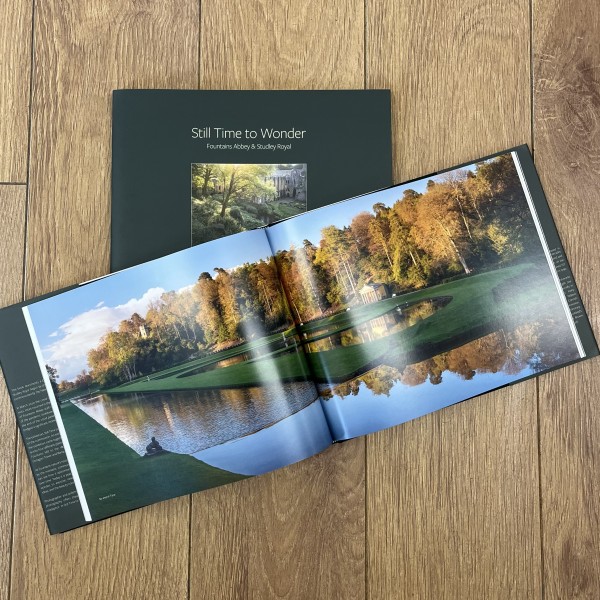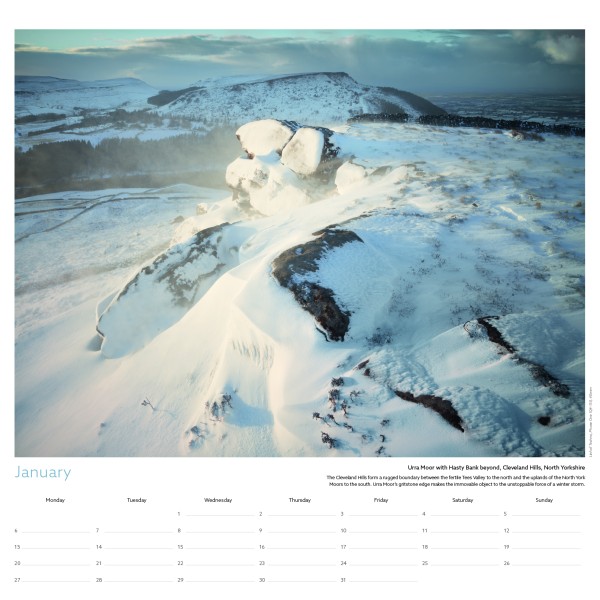Still Time To Wonder








Choose Printing Options |
|
|
Format
Quantity
Price
£
 excl. VAT
£
excl. VAT
£  inc. VAT
inc. VAT
Plus postage and packaging, from £9.60 inc VAT per order, calculated in the checkout.
|
Our last despatch day is Monday 22nd December.
(For Overseas, please order by Sunday 14th December)
We cannot guarantee delivery before Christmas.
We will then despatch again on our return, Monday 5th January.
£10 OFF when you use code ST2W10 at the checkout
Fountains Abbey & Studley Royal
This book documents a body of work begun early in 2019, commissioned by the National Trust the preceding year. I was given an open, creative brief, with time to become truly familiar with the territory. Inspiration came early from the extraordinary ancient trees of the deer park. I was particularly moved by the gigantic carcasses of dead trees and their branches lying on the ground; sculptural and organic, they are returning their biomass and energy to the land that bore them.
With each visit I started to find compositions which reflected my sense of place. When I stayed overnight I had a chance to walk the grounds early and late, seeing the estate at its quietest, at sunrise, sunset and in twilight.
In March 2020 the covid-19 pandemic brought an abrupt halt to visits. But with the support of Justin Scully and the NT Fountains team I resumed photography here in the summer of 2020, and continued throughout all seasons in 2021. The final images in the exhibition were taken in early 2022. Made before, during and approaching the end of the covid pandemic, 2019 - 2022, the creative process has bridged a significant moment in history.
Undeniably, most of my work falls firmly within the eyewitness tradition of documentary photography. That is certainly true of the Fountains Abbey project. Sometimes significant editing is required to achieve a balance of colour, tone, and sense of light in the final print. The goal is to bring the landscape and its details to life; essentially, to ensure it has its own reality. And reality is the goal for anyone whose mission is to photograph the world as it is, in any given moment. This may not sound like a particularly “creative” process, especially in a digital world where departure away from facts and into fantasy is incredibly easy. Nevertheless, an enormous amount of creative effort and energy is used in considering how to frame any scene, and to do so with a high level of craft, and then to translate that depiction into a convincing print on paper.
I believe that photography can work on multiple levels, offering, as the photographer and polemicist RobertAdams has said, three verities – geography, autobiography, and metaphor. All three are important aspects for the landscape artist, and given the uncertain future, the role of photographer as geographer now matters more than ever.
My wanderings around the site provoked rumination on the history, mission and meaning of the Abbey and its landscape, humanity and the wider world. I began to gather those thoughts into written form; an edited stream of ideas and reflections. These were recorded for listening via headphones in the exhibition. Here they appear towards the end of the book in written form, entitled, “Passage of Time”. I hope the words make a useful counterpoint, and complement the photographs.
We live in an anxious age, overshadowed by climate change, habitat loss, global pandemics, and geo-political conflict. Yet I am an optimist, a condition developed partly from photographing the resilience and bounce-back-ability of nature over the course of four decades. I hope my work shows that nature and humanity are deeply connected. We depend on clean air, water, and soil fertility for life, but we also need nature's beauty on a spiritual level.
Why, “Still Time to Wonder”? Firstly the word Still is the essence of the photographer's art. A photograph is a crystallised moment and must work as such. Secondly, Time is also photographically fundamental as the word moment suggests. A photograph is a manifestation from the Space/Time/Form continuum. Time also has a special meaning for this work which was extended by a year due to the pandemic. Time to walk, to think, to reflect; and then time to repeat. Time was the gift I was given.
Finally, the Wonder of the North is a title bestowed on Fountains by Mark Newman, via 18th century commentator John Tracy Atkins. To borrow Wonder from them is to respect and confirm an impression of the place that most will share. Wonder in my title though is a verb. In this sense it evokes a leap of the imagination, a suitable metaphor for this wonderful landscape.
Joe Cornish | October 2022
Other products you might be interested in...
Coast and Wildwood, Moor and Mountain 2026












Our last despatch day is Monday 22nd December.
(For Overseas, please order by Sunday 14th December)
We cannot guarantee delivery before Christmas.
We will then despatch again on our return, Monday 5th January.
The principle mission of this calendar is to focus on the wild places that remain in the UK. Since our landscape is so heavily utilised and managed these places are not necessarily that common. Yet wild fringes can be found throughout the country and they are all important, even the hedgerows and small scraps of wild land that abut fields and meadows. The wider expanses of forest and coast are often major wildlife refuges, and while Britain lacks apex predators on land (humans apart) our coastal regions especially are internationally important for nesting and migrating birds.
In 2024 I broke my neck in an accident on Cul Mor, Assynt Scotland, and I wish to record once again how enormously grateful I am to my stalwart companions, and to the Assynt Mountain Rescue Team for co-ordinating my helicopter rescue from the hill that day. Since then nothing has helped more in my recovery than being able to walk regularly in our local woods.
I'd like to think that these pictures are also a reminder that encountering natural beauty is a solace for the soul, evidence for the therapeutic value of nature and the very human need to reconnect with it. However busy and stressful our lives are, walking through the woods, or by the coast, over the moors or up a mountain can help heal the wounds.
Woodland Sanctuary *Sold Out*




















SOLD OUT
Woodland Sanctuary
Trees and Woodland of the North York Moors
Woodland Sanctuary is a joint exhibition between photographers Simon Baxter and Joe Cornish. The work was gathered over five years, all of it within the North York Moors National Park.
For both photographers woodland has been a source of exploration, tranquillity, meditation, artistic study and inspiration. Throughout the pandemic it was also a place of a solace. The photography has been made in the eyewitness tradition of the medium, which is to say that the photographs are a faithful record of the scene before the camera.
One obvious restriction that arose from the pandemic was the inevitable necessity of staying at home. But no travel created an opportunity to explore the local area more widely and deeply. For Simon Baxter that was more or less an extension of his existing practice. For me, it was a chance to deepen the local emphasis I had taken years before, but with a growing focus on woodland.
In our different ways this converging concentration on woodland had happened almost simultaneously. Simon's injuries had led him into the woods as a solace and relief from persistent pain. For me it was a growing fascination with trees and forest driven in part by increasing alarm about the environmental crisis. Whatever our motivation we both found therapeutic value and artistic inspiration among trees. It wasn't until May 2019 when we were comparing notes via email that Simon kindly suggested sharing a location he'd discovered. It turned out I had walked through the same woodland the previous month with friends, and was intrigued to join him. It was the first of many shared excursions.
The work we had done before, and still the majority since have been solitary trips, as is usual in landscape photography. But increasingly as we exchanged pictures and ideas there was a sense of solidarity and shared inspiration. The coming of the pandemic accelerated the process (for me especially) as the distractions of more distant travel evaporated.
We recognised that while our work was distinct, the similarities were based on a shared value of respecting the appearance of things as they really are, photographically-speaking. And this attachment to visual reality is the philosophical basis for the exhibition, and for this slim book. The work is made in what some call: the Eyewitness tradition. There is always a degree of translation and interpretation in photography. It is not reality after all. But the sense should be that what we saw could have been seen by anyone else standing next to the photographer in that moment.
Natural woodland, forest and trees are no longer taken for granted by policy-makers and corporations. Countless books have appeared about them recently revealing their scientific details, community relations, their cultural and evolutionary importance, their endless utility to humans etc. They are recognised for the critical role they play in the biosphere, and in our wider culture. In this new atmosphere of interest in and understanding of trees it seemed our own fascination for them was timely.
The Inspired By gallery at Danby Lodge in the North York Moors seemed the perfect place to hold an exhibition focussing exclusively on the woodland of this wonderful regional National Park. We are so grateful for the opportunity to show this exhibition here.
This book is its hand-held equivalent. It is a record of the pictures and words from the exhibition. It also contains a few pictures for which there was insufficient space in the gallery! Arranged in a series of artistically inspired themes, we hope the photographs convey a sense of joy and wonder, and sometimes other complex emotions that can be triggered by looking at trees, and walking through the woods.
Joe Cornish, June 2022


